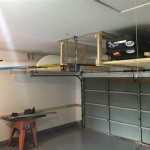How To Make A Homemade Garage Door Opener
The automation of garage doors provides convenience and security. While commercial garage door openers are readily available, constructing a homemade version presents an opportunity to understand the underlying principles of such systems. This endeavor necessitates a foundational understanding of electrical circuits, mechanical components, and safety protocols.
This article outlines the fundamental steps involved in building a functional garage door opener. It emphasizes the importance of safety precautions and highlights potential challenges associated with this project. The information provided is intended for individuals with prior experience in electronics and mechanics. It is assumed that the reader possesses the necessary tools, skills, and a safe working environment.
Understanding the Basic Components
A garage door opener, at its core, comprises an electric motor, a drive mechanism, a control system, and safety features. The electric motor provides the power to lift and lower the garage door. The drive mechanism translates the motor's rotational motion into the linear motion required to move the door along its tracks. The control system manages the motor's operation, responding to input from remote controls, wall-mounted switches, and safety sensors. Safety features, such as photoelectric sensors, are crucial for preventing accidents during operation.
Choosing the right motor is paramount. A DC motor with sufficient torque and a suitable voltage rating is typically recommended. Gearboxes can be integrated to reduce the motor's speed and increase its torque output. The drive mechanism can be implemented using various methods, including a chain drive, a belt drive, or a screw drive. Each mechanism has its own advantages and disadvantages in terms of cost, durability, and noise level.
The control system can range from a simple relay-based circuit to a more sophisticated microcontroller-based system. A relay-based system is relatively straightforward to implement but offers limited functionality. A microcontroller-based system allows for advanced features such as programmable timers, remote control integration, and safety monitoring.
Essential safety features include photoelectric sensors (also know as safety beams) that detect obstructions in the path of the garage door. If an obstruction is detected, the sensors immediately stop or reverse the door's motion. A pressure sensor on the door itself can also serve as a safety mechanism, halting the door's operation if it encounters resistance.
Choosing a Drive Mechanism and Appropriate Motor
Selecting the appropriate drive mechanism and motor is critical to the functionality and longevity of the homemade garage door opener. Several options exist, each with its own merits and drawbacks.
A chain drive system utilizes a chain connecting the motor to the garage door. It is relatively inexpensive and durable, making it a common choice for commercially available openers. However, chain drives can be noisy and require regular lubrication. The chain and sprocket sizes must be carefully selected to ensure proper alignment and smooth operation.
A belt drive system employs a reinforced belt to transmit power. Compared to chain drives, belt drives are quieter and require less maintenance. However, they may be more expensive and less durable over extended periods of heavy use. The belt's tension must be properly adjusted to prevent slippage and ensure efficient operation.
A screw drive system uses a threaded rod to move the garage door. This system is relatively simple to implement and requires minimal maintenance. Screw drive systems can be more expensive than chain or belt drives and may be slower in operation. The threaded rod must be properly lubricated to reduce friction and prevent wear.
The selection of the motor is equally important. A DC motor with a voltage rating that matches the available power supply is essential. The motor's torque output must be sufficient to lift and lower the garage door without straining the motor. A gearbox can be used to reduce the motor's speed and increase its torque output. Consider a motor with built-in thermal protection to prevent overheating and prolong its lifespan.
Building the Control System and Implementing Safety Features
The control system is the brain of the garage door opener, managing the motor's operation based on input from various sources. Implementing effective safety features is paramount to preventing accidents.
A basic relay-based control system can be constructed using multiple relays to control the motor's direction of rotation. A momentary switch or remote control receiver can activate the relays, causing the motor to either open or close the garage door. Limit switches can be incorporated to automatically stop the motor when the door reaches the fully open or fully closed position. These switches prevent the motor from overrunning and potentially damaging the door or the opener.
A more advanced control system can be implemented using a microcontroller. Microcontrollers allow for greater flexibility and control over the garage door opener's operation. They can be programmed to implement features such as programmable timers, remote control integration with rolling codes for enhanced security, and safety monitoring. Sensors can be connected to the microcontroller to detect the door's position and any obstructions in its path.
Photoelectric sensors, often referred to as safety beams, are an indispensable safety feature. These sensors consist of a transmitter that emits an infrared beam and a receiver that detects the beam. The transmitter and receiver are positioned on opposite sides of the garage door opening, near the floor. If an obstruction breaks the infrared beam, the receiver signals the control system to stop or reverse the door's motion, preventing the door from closing on the obstruction.
A pressure sensor, mounted on the garage door itself, can also serve as a safety mechanism. This sensor detects resistance encountered by the door during its operation. If the door encounters an obstruction, the pressure sensor triggers the control system to stop or reverse the door's motion. This feature is especially useful for detecting smaller obstructions that may not be detected by the photoelectric sensors.
Integrating an emergency release mechanism is critical for manual operation in case of power outages or system failures. This mechanism typically consists of a pull cord connected to a release lever on the drive mechanism. Pulling the cord disengages the motor from the door, allowing the door to be opened or closed manually.
Wiring and Installation Considerations
Proper wiring and installation are crucial for the safe and reliable operation of the homemade garage door opener. Adherence to electrical codes and safety regulations is imperative.
All wiring connections should be made using appropriate connectors and wire gauges. Ensure that all connections are secure and properly insulated to prevent short circuits and electrical hazards. Use strain relief clamps to prevent wires from being pulled or damaged. Grounding the electrical components is essential for safety.
The garage door opener should be securely mounted to the garage ceiling or wall using appropriate hardware. Ensure that the mounting surface is strong enough to support the weight of the opener. The drive mechanism should be properly aligned with the garage door track to ensure smooth operation. Adjust the limit switches to ensure that the door stops at the correct positions. Test the safety features thoroughly after installation to ensure that they are functioning correctly.
When working with electrical components, always disconnect the power supply before making any connections or adjustments. Use a multimeter to verify that there is no voltage present before touching any wires. Wear appropriate personal protective equipment, such as safety glasses and gloves. If unsure about any aspect of the wiring or installation, consult a qualified electrician.
Regular maintenance is essential for the continued safe and reliable operation of the garage door opener. Lubricate the drive mechanism regularly to reduce friction and prevent wear. Inspect the wiring for any signs of damage. Check the tension of the chain or belt. Test the safety features periodically to ensure that they are functioning correctly. Repair or replace any damaged components promptly.

How To Install A Garage Door Opener With Pictures Wikihow

Roll Up Automatic Garage Door Opener

Farm Show The Best Stories About Made It Myself Inventions Farming And Gardening Tips Time Saving Tricks S Diy Projects On Boosting Your Income

Diy Garage Door Opener Installed On A Steel Building

How To Install A Garage Door Opener With Pictures Wikihow

How To Install A Garage Door Opener The Home Depot

How To Install A Garage Door Opener With Pictures Wikihow

Free Automatic Gate Opener Plans By Keith Vickers

How To Install A Garage Door Opener The Home Depot

Tips And Instructions For Building A Superior Overhead Garage Door
Related Posts








